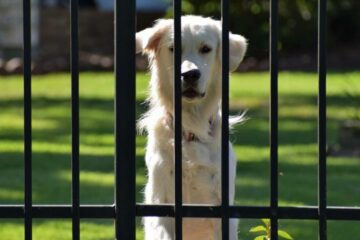How to Stop Dog Growling at Strangers (And Barking Too!)
Dog barks and growls at strangers? You’re probably worried about what might happen if they take things too far, right? Of course, and who wouldn’t be? That’s why it’s so important that you learn how to stop your dog growling at strangers, and in this article, we’re going to teach you the exact steps to accomplish that.
We’ll explore why dogs growl or bark at strangers, and what it might mean about their intentions. We’ll give you the steps to calm both adult dogs and puppies around strangers so that they’ll stay quiet and relaxed in these situations. Keep reading for the tips and techniques you need to help your dog feel at ease!
How to Stop Dog Growling at Strangers

If your dog growls at strangers, the reaction often stems from fear, territorial instincts, or a lack of proper socialization. Understanding why your dog reacts this way is the first step towards helping them become more comfortable and less reactive around new people.
Why Does My Dog Growl at Strangers?
Your dog growls at strangers primarily due to fear or protective instincts. Dogs may perceive strangers as potential threats, especially if they haven’t been adequately socialized. Other factors such as past negative experiences, lack of confidence, or territorial behavior can also contribute to this reaction.
Dog Growls at Strangers: Signs They’ll Attack
If your dog growls at strangers, it’s important to recognize the signs that may indicate a potential attack. These include stiff body posture, bared teeth, focused staring, and a raised hackle. If you notice any of these, you should intervene and remove your dog from the situation right away.
How to Stop a Dog From Growling at Strangers
To stop your dog from growling at strangers, a combination of training and positive reinforcement is effective. Here’s a brief guide on how to train the ‘sit-stay’ command:
- Begin in a quiet environment with minimal distractions.
- Ask your dog to ‘sit.’ Once they are sitting, give them the command to ‘stay.’
- Reward them with treats and praise for staying in place.
- Gradually increase the duration of the ‘stay’ and introduce new environments with more distractions.
This command helps manage your dog’s reactions to strangers by keeping them focused and under control, reducing the likelihood of growling or aggressive responses.
Your dog growling at strangers can be managed with consistent training, understanding the root cause of the behavior, and slowly introducing them to new people in a controlled, positive manner.
It’s important to remember, however, that the underlying behavioral issues (overprotectiveness, fear, territoriality, etc.) that were causing all of this to begin with will still be present. And until you address those, any positive changes you see will only be temporary.
“Well, how do I make these changes last?”
By getting your dog to truly choose to follow your direction, that’s how. I tried many times to write out how you can do that before deciding it made more sense to just link you to the free video series that explains it better than I’d ever be able to.
The series is by a man named Dan who is one of the world’s leading dog obedience trainers. In it, he teaches you how to put an end to things like your dog growling at strangers and all other misbehavior using his fast and easy-to-follow methods.
In the first video, Dan will reveal to you why the two most common methods of dog training only doom you to failure. You can watch the video now by clicking here. Follow the proven system he’ll show you in his series and you’ll never have to spend another second worrying about why your dog growls at strangers ever again!
Dog Barks and Growls at Strangers

When a dog barks and growls at strangers, the reaction is typically a form of communication expressing fear, discomfort, or territoriality. Understanding why your dog behaves this way is essential to effectively address the behavior and help your dog feel more at ease around strangers.
Why Do Dogs Bark at Strangers?
Dogs bark at strangers primarily as a response to perceived threats, to alert their owners, or due to excitement or anxiety. This behavior can be influenced by the dog’s breed, past experiences, level of socialization, and even their general temperament.
Additionally, some dogs may bark as a learned response if they have been inadvertently rewarded for this behavior in the past. Identifying the specific triggers for your dog’s barking can guide the approach to managing and modifying this behavior.
Learn the command that will help calm and control your dog in these situations by going back to the first section now.
Rescue Dog Growls at Strangers
Rescue dogs may growl at strangers often due to their past experiences and uncertain histories. They might have had negative encounters with people in the past or lacked proper socialization. In these cases, it’s important to build trust and a sense of security for the dog.
Patience, gradual exposure to new people in a controlled, positive manner, and creating a safe environment can help build their confidence and reduce fear-based growling. Consistent, positive experiences with strangers can gradually change their perception and response.
Dog Growls at Strangers on Walks
If your dog growls at strangers on walks, it might be due to overstimulation, protective instincts, or fear. Overstimulation in a busy environment can lead to heightened anxiety, resulting in growling. To address this, it’s important to create positive associations with seeing strangers.
This can involve offering treats and praise when your dog notices a stranger but remains calm. Training your dog to focus on you during walks, using commands like ‘watch me’ or ‘heel,’ can also help manage their reactions and keep their attention away from external stimuli.
In conclusion, a dog that barks and growls at strangers is displaying a natural form of communication that can stem from various underlying causes. By understanding these reasons and applying consistent training and positive reinforcement, you can help your dog become more comfortable and less reactive in the presence of strangers.
Puppy Growling at Strangers

When a puppy growls at strangers, the reaction often stems from fear, uncertainty, or a lack of socialization with different types of people. Understanding the reasons behind your puppy’s growling is crucial for helping them feel more comfortable and confident around strangers.
Why Is My Puppy Growling at Strangers?
Your puppy is growling at strangers due to feelings of fear, discomfort, or as a defensive response. This behavior can be influenced by their early experiences, their inherent temperament, and how they’ve been socialized.
Puppies are still learning about the world around them, and unfamiliar people can seem intimidating. Inadequate exposure to a variety of people and situations can exacerbate this issue, making social encounters more stressful for them, leading to growling and maybe even biting.
Puppy Barks at Strangers: Are They Playing?
When a puppy barks at strangers, it can sometimes be mistaken for playfulness, but it’s important to accurately interpret the behavior. Playful barking usually involves a relaxed body language, wagging tail, and sometimes even a play bow, indicating a desire to engage in fun.
In contrast, barking due to fear or aggression may involve a stiff body posture, a more intense bark, and possibly other signs of discomfort like backing away or hiding.
How to Calm Puppy Around Strangers
Calming a puppy around strangers involves gradual and positive socialization. It’s a good idea to introduce your puppy to a variety of people in different settings, always ensuring that these experiences are positive and non-threatening.
Using treats and praises to reward calm behavior can reinforce good manners. Teaching basic obedience commands in these situations can also provide a way to distract and focus your puppy, making interactions with strangers less overwhelming for them. We have an important for you to learn now in the first section.
In conclusion, a puppy growling at strangers is a common issue that can usually be resolved with proper training and socialization. By understanding the cause of the growling and gently exposing your puppy to a variety of people in positive contexts, you can help them become more comfortable and well-adjusted around strangers.
I’m sure you’re ready to get going now that you have all of your questions about why your dog barks and growls at strangers answered, so I’ll let you begin. Best wishes, and thank you for reading our article “How to Stop Dog Growling at Strangers (And Barking Too!)”.





